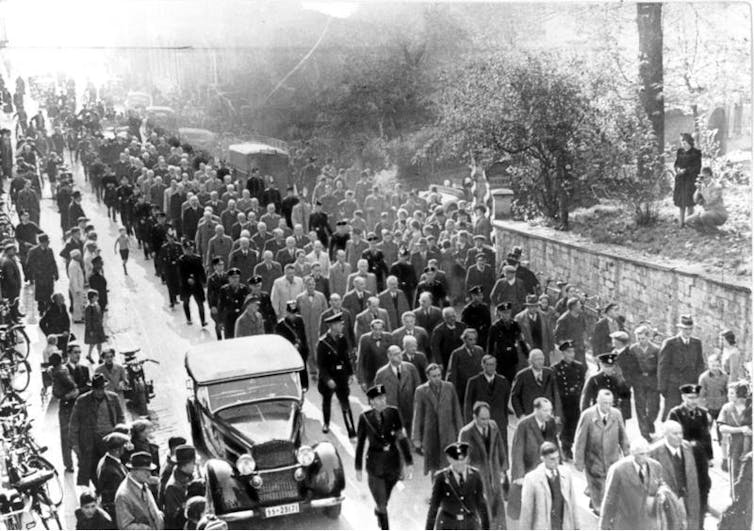
Martin Goodman, University of Hull
On the evening of November 9, 1938, a Nazi pogrom raged across German and Austrian cities. Nazis branded the atrocity with a poetic term: Kristallnacht or “Crystal Night”. In that branding, fiction took hold. In English it translates as “The Night of Broken Glass” but that also tames the horror. Yes, broken glass from Jewish shopfront windows littered the streets, but also hundreds of synagogues and Jewish businesses were burned to the ground while Jews were beaten, imprisoned and killed.
Eight decades later, novelists are still trying to make sense of the pogrom – which was was designed to give the Nazi Party’s antisemitic agenda the legitimacy of public support.

Bundesarchiv Bild
Kristallnacht marked a new epoch. Earlier pogroms, such as in Russia, were popular riots – now, for the first time, an industrial nation turned the forces of the state against an ethnic group within its own borders. To get away with this, a state needs to control the narrative. In this instance, propaganda minister Joseph Goebbels was the key player. When a young Polish Jew named Herschel Grynszpan entered the German Embassy in Paris and shot a German official, Goebbels saw the possibilities. He used news of the event to trigger Kristallnacht.
Fear and disbelief
The state that attacks its citizens also turns on its writers and free-thinkers – people who can construct a counter-narrative. The future Nobel Prize-winner Elias Canetti and his wife, the writer Veza, were such people. “We shall remember this November”, a Jewish character reflects in Veza Canetti’s novel The Tortoises, “when we are all being punished because a child went wrong and was led astray”.
In the wake of Kristallnacht, the Canettis fled Vienna for Paris and by January 1939 had settled in exile in London, where, in a feverish three months, Veza wrote her novel (unpublished until this century). It provides a window on how intellectuals fought to understand the unimaginable as it unfolded. “The temples are burning!” says one character. “Can you believe that’s possible?” asks another. So why don’t they go and see for themselves? “People haven’t the heart. They feel like criminals. They believe the temple will strike them down if they watch and don’t do anything about it.”
Emil and Karl, the first published novel to feature the pogrom, came out in New York in February 1940. Yankev Glatshteyn, a Polish Jew and immigrant to the US, wrote it in Yiddish to alert American Jewish youngsters to the perils facing their European kindred. It features two friends, one a Jewish boy and the other the son of socialists. Forced to scrub streets clean with their hands after Kristallnacht, both boys learn they must flee their country if they are to stay alive.

Amazon
Christa Wolf, who forged life as a writer in what became East Germany, fed her memories of the night into Nelly, a character in her 1976 novel A Model Childhood. Nelly knew nothing of Jews, but in that pogrom she witnessed a burning synagogue. “It wouldn’t have taken much for Nelly to have succumbed to an improper emotion: compassion,” Wolf reflected. “But healthy German common sense built a barrier against it: fear.” These asides of bitter irony note the chilling reality of the time: those who showed sympathy for the plight of the Jews risked sharing their plight.
Still burning
So to the 21st century. With events such as Kristallnacht locked away in history, what use are we novelists? Novels unlock history. Governments maintain their hold on narratives that justify abuses of power – but novelists can invert that narrative order to reveal neglected viewpoints.
In 2009, Laurent Binet novelised the life and death of Reinhard Heydrich (a man known as “Hitler’s Brain” – the German acronym which gives the book its title: HHhH. Under orders from Goebbels, Heydrich set the November pogrom in motion. Binet maintains clinical control of the story, anchoring it to archived fact. Heydrich is shown measuring Kristallnacht’s efficiency, including the cost of all the broken glass.

Center for Jewish History, New York
In Michele Zackheim’s Last Train to Paris (2013) an American Jewish female journalist is dispatched into Nazi-controlled Berlin. Highlighted here is not the broken glass, but the fires.
[With] no wind, clouds of smoke were perched on top of each burning building. In between the buildings, perversely, as if Mother Nature were laughing at our idiocy, we could see the stars.
Those fires also burn a synagogue in a remote Austrian town in The Lost Letter, the 2017 novel by Jillian Cantor – a novelist who focuses on 20th-century history. Cantor’s novel follows Zackheim’s in looking back over decades, seeking emotional engagement with distant tragedy.
All the toys in the world
Günter Grass was ten on Kristallnacht, the same age as Oskar in his novel The Tin Drum (1952). The Jewish toyshop that supplied Oskar’s drum was burned down that night and the shop owner killed himself – “he took along with him all the toys in the world”. A character akin to Grass appears in John Boyne’s 2018 novel A Ladder to the Sky. In his teens Grass joined the Waffen-SS – a fact he kept secret until old age.

Federal Archives, CC BY-ND
In Boyne’s book, the central character, a writer, took actions after Kristallnacht that destroyed a Jewish family. Like Grass he contained the story for decades. Of course, the true storyteller must share and not conceal stories. Wolf showed us how fear was a barrier against compassion. Boyne makes us face the consequences of overcoming such fear.
Once people would have said Kristallnacht was unimaginable in a modern context. But they were wrong – do Roma feel safe from the actions of the Hungarian State today? How safe are the Rohingya in Myanmar, Mexicans in the US, the Windrush generation in the UK?
Through fiction we can enter history, encounter suffering and exercise compassion. We close our book, awakened. Fiction sharpens memory for when history repeats itself.![]()
Martin Goodman, Professor of Creative Writing, University of Hull
This article is republished from The Conversation under a Creative Commons license. Read the original article.




24 Comments
Pingback: ราคาบอลวันนี้
Pingback: สล็อตวอเลท ฝาก ถอน ออโต้
Pingback: เดิมพันออนไลน์
Pingback: u31 com
Pingback: ข่าวบอล
Pingback: เน็ต ais
Pingback: ลวดสลิง
Pingback: ติดเน็ตบ้าน AIS
Pingback: sell drugs
Pingback: SEO Affiliate Domination
Pingback: Stapelstein Balance Board Schemerblauw
Pingback: เกมคาสิโน ที่เปิดให้บริการ ภายในค่าย dg casino
Pingback: ป้ายอัฐิ
Pingback: Bilad Al-Rafidain
Pingback: Slotonline-th สล็อตเว็บตรง
Pingback: กติกา การเล่นบาคาร่า
Pingback: pgslot
Pingback: top models
Pingback: ฟิลเลอร์
Pingback: ทดลองเล่นสล็อต pg
Pingback: Rec1688 ทางเข้าเว็บเดิมพันออนไลน์เว็บตรง
Pingback: 168galaxy คืออะไร ?
Pingback: my profile
Pingback: OLE777